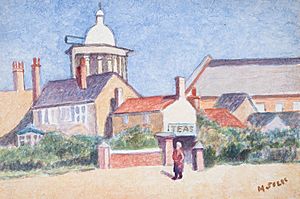Kursaal (amusement park) facts for kids

View of the front of the Kursaal
|
|
| Location | Southend-on-Sea, Essex, United Kingdom |
|---|---|
| Coordinates | 51°31′59″N 0°43′29″E / 51.5331°N 0.7247°E |
| Status | Operating |
| Opened | 1901 |
The Kursaal is a special historic building in Southend-on-Sea, Essex, England. It first opened in 1901 as part of one of the world's very first amusement parks built just for fun! The main building is famous for its unique dome. This dome was even shown on a special Royal Mail stamp.
Contents
History of The Kursaal
How The Kursaal Started (1894)
The land where the Kursaal stands today was bought in 1893. In 1894, a father and son, Alfred and Bernard Wiltshire Tollhurst, opened it as the 'Marine Park and Gardens'.
In July 1901, they opened a grand new building called the Kursaal Palace. It had a circus, a ballroom for dancing, an arcade with games, a dining hall, and a billiard room. The word Kursaal comes from German and means a "Cure Hall" or spa. It was used to mean a place for healthy and fun entertainment. Southend's Kursaal became the biggest fairground in the south of England!
The Luna Park Years (1910)
Later, in 1910, a new company called Luna Park bought the Kursaal. They changed the park's name to Luna Park. The new owner, William Hilton, added many exciting attractions. These included roller coasters like the Harton Scenic Railway and the Figure of Eight. There was also a miniature railway, a circus, and even a cinema.
Luna Park was very popular, with many visitors each week. However, in June 1911, a fire sadly destroyed two popular rides: the Joy Wheel and the Figure of Eight Railway Coaster. The Luna Park Company eventually closed down in 1915.
The Morehouse Family Takes Over (1915)
In 1915, an American businessman named Clifton Jay Morehouse became the new owner. He brought back the original name, 'The Kursaal'. He changed the circus area into a ballroom and even an ice rink! He made the park one of the most successful in England. He also hosted local sports events and trade shows.
In 1916, a small zoo opened at the Kursaal, with animals like bears, tigers, and wolves. But the zoo had to close when World War II started.
Clifton Jay Morehouse passed away in 1920. His son, David de Forrest Morehouse, took over running the park. In 1929, there was an accident on a ride called the Flying Boat, where some people were hurt. David de Forrest Morehouse also passed away in 1934. The Kursaal then closed to the public during World War II.
Greyhound Racing at The Kursaal (1927–1929)
For a short time, from 1927 to 1929, the Kursaal also hosted greyhound racing. This is a sport where dogs race around a track. The first race meeting attracted 5,000 people! However, the racing only lasted for two years. It then moved to a different location because the rent for the Kursaal site went up.
The Kursaal After the War (1948)
After World War II, in 1948, Clifton J. Morehouse II, another member of the Morehouse family, took over the Kursaal. The ballroom at the Kursaal had always been a place for music and entertainment since it opened in 1901.
In the 1970s, the Kursaal became a famous place for rock music. Many internationally successful bands played there, like Black Sabbath, Deep Purple, Thin Lizzy, Queen, and AC/DC. A photo of AC/DC playing at The Kursaal in 1977 was even used on the front cover of their album, Let There Be Rock!
Decline and Closure (1973–1986)
The Kursaal slowly became less popular starting in the early 1970s. The outdoor rides and amusements closed in 1973. At the end of 1977, the ballroom also closed. Finally, the main Kursaal building closed its doors in 1986. The area where the outdoor rides used to be was later used to build houses.
The Main Building Reopens (1998)
In 1998, the main Kursaal building was reopened after a huge renovation. It became a place with a bowling alley, a casino, and other fun activities. For a while, it even had a McDonald's restaurant, but that closed in 2008.
Sadly, the bowling alley closed in 2019, and the casino closed in 2020. Today, only a Tesco Express store is open in a part of this historic building.
List of Rides and Attractions
Over the years, the Kursaal had many different rides and attractions. Here are some of them:
- The Skids/Swirls
- Bumper Cars
- The Morehouse Galloper (1954–1973)
- Ski Jump
- Waltzer
- ROTOR (1960s)
- Wild Mouse (1960s)
- Calypso (1962–1983?)
- Cyclone, a roller coaster over 18 metres (59 ft) high (1937–1973)
- Harton Scenic Railway (1910–1973)
- Switchback Railway
- 1st Water Chute (1921–1957)
- 2nd Water Chute (1958–1971)
- Toboggan Slide (1925–present) previously Ice Toboggan
- The Mont Blanc (1933–1973)
- Laff In The Dark (1938–1973)
- Aerial Flight (1894–1973)
- Figure of Eight Coaster (1910–1947)
- Arctic River Caves
- Joy Wheel (around 1910)
- Bowl Slide
- Airsport (?–1973)
- Miniature Railway
- The Whip (1921–?)
- The Tumblers (1921–?)
- Never Stop Railway (1923–?)
- Autodrome (1927–?)
- Wall Of Death (1929–?)
- Midget Mansion (1930–?)
- Caterpillar
- Jolly Tubes (1920s–?)
- Whirlpool (<1950s–1973)
- Dive Bomber (1950s–1959)
- Noahs Ark (1953–?)
- Ghost Train (1931–?)
- Petboats (1933–?)
- Mountain Dipper (1933–?)
- The Whirlwind Racer (1930s–?)
- Tumblebug (1938–?)
- Seaplane (1938–?)
- Stratosphere or Stratosphere Rocket (1945–?)
- The Under & Over (?–1973)
- Knock the lady out of bed
- Kelly's house or Kelly's cottage (destroyed by fire)



